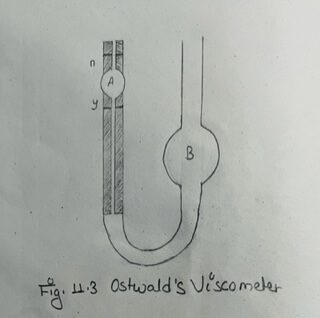THEORY:
Viscosity (like surface tension) is another property of a liquid that depends upon the intermolecular forces of attraction between the liquid molecules.
Viscosity is defined as the resistance to the flow of liquid. That is, it is the internal friction or resistance that one layer of a liquid moving with a certain velocity offers to another adjacent layer moving with a different velocity.
The viscosity of a liquid compared to water can be determined by using Ostwald’s visco-meter and the following formula.
η1/ηw = d1t1/dwtw
Where, η1 = viscosity of the liquid
ηw =viscosity of water.
t₁ = time of flow of liquid
tw = time of flow of water
d1 = density of liquid
dw = density of water

APPARATUS :
1. Ostwald’s viscometer
2. Pyknometer or specific gravity bottle
3. Stop watch
4. Pipette
5. Beaker
PROCEDURE:
i) Clean the Ostwald’s viscometer first with chromic acid and then with distilled water. Attach a rubber tube to the limb containing the bulb A.
ii) Drop from a measuring pipette a definite volume of water Into the viscometer through the right hand limb B.
iii) suck the water with the rubber tube upto a level above the upper mark of the viscometer. Allow the water to flow down the capillary tube. Start the stop watch when the water level reaches the upper mark, and stop it when the level reaches the lower mark. Note the time of fall, and repeat the process three times.
iv) Empty the viscometer and dry it by passing hot air. And repeat the experiment three times with the same volume of the experimental liquid.
v) Determine the weight of empty pyknometer (or specific gravity bottle). Next, fill the pyknometer with distilled water, and take its weight. Now, empty the pyknometer and dry it. Finally, take the weight of pyknometer filled with the experimental liquid..
RESULTS:
Room temperature at the time of experiment = t°C.
Viscosity of water at t°C (ηw) = ………. Centipoise.
| No.of obs. | Flow time forwater (tw) | Mean (tw) | Flow time forliquid (t₁) | Mean (t1) |
| 1 | ||||
| 2 | ||||
| 3 |
Wt of empty pycnometer = W₁
Wt of pyknometer + water = W₂
Wt of pyknometer + liquid = Ww
therefore, Wt of water in the pyknometer = (W₂ – W₁) gm
therefore, Wt of liquid in the pyknometer = (W3-W₁) g.
therefore, d1/dw = W3 – W1/W2 – W₁
Calculate the viscosity of the liquid by using the relation.
η1 = d1t1 / dwtw x ηw centipoise.
